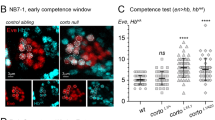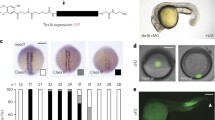Abstract
Genetic controls regulating the establishment of the pharyngeal primordia in the anterior region of the Drosophila embryo were investigated through the analysis of the expression of thecnc gene, which is continuously expressed specificially in three pharyngeal segments. The spatial regulation ofcnc gene transcription was analyzed by in situ hybridization of CNC transcript-specific probes to embryos mutant for other cephalic patterning genes. The anterior domain of CNC expression (corresponding to the labral segment primordium) was found to be activated bybicoid andtorso maternal pathways, independently of known zygotic gap genes, and sequentially constricted to its final size by repression from neighboring region-specific genes. Control of the posterior domain (corresponding to the intercalary and mandibular segment primordia) involved combinatorial regulation by zygotic gap genes: activation by thebtd gap gene and repression from theotd gap gene anteriorly and thesna gene ventrally. Surprisingly, the posterior domain was shifted relative to the segmentation plan in mutants of theems gap gene. These regulatory controls establishing the limits of CNC expression in the pharyngeal primordia suggest that one mechanism for patterning within the anterior terminal region may involve direct activation of region-specific gene(s) by maternal factors over a relatively broad domain followed by constriction of that domain by repression from adjacently activated zygotic genes.
Similar content being viewed by others
References
Alberga A, Boulay J-L, Kempe E, Dennefeld C, Haenlin M (1991) Thesnail gene required for mesoderm formation inDrosophila is expressed dynamically in derivatives of all three germ layers. Development 111:983–992
Berleth T, Burri M, Thoma G, Bopp D, Richstein S, Frigerio G, Noll M, Nüsslein-Volhard C (1988) The role ofbicoid RNA in organizing the anterior pattern of theDrosophila embryo. EMBO J 7:1749–1756
Bowerman B, Eaton BA, Priess JR (1992)skn-1, a maternally expressed gene required to specify the fate of ventral blastomeres in the earlyC. elegans embryo. Cell 68:1061–1076
Brönner G, Jäckle H (1991) Control and function of terminal gap gene activity in the posterior pole of theDrosophila embryo. Mech Dev 35:205–212
Casanova J, Struhl G (1989) Localized surface activity oftorso, a receptor tyrosine kinase, specifies terminal body pattern inDrosophila. Genes Dev 3:2025–2038
Cohen S, Jürgens G (1990) Gap-like segmentation genes that mediateDrosophila head development. Nature 346:482–485
Dalton D, Chadwick R, McGinnis W (1989) Expression and embryonic function ofempty spiracles: aDrosophila homeobox gene with two patterning functions in the anterior-posterior axis of the embryo. Genes Dev 3:2025–2038
DiNardo S, O'Farrell PH (1987) Establishment and refinement of segmental pattern in theDrosophila embryo: spatial control ofengrailed expression by pair-rule genes. Genes Dev 1:1212–1224
Diederich RJ, Merrill VKL, Pultz MA, Kaufman TC (1989) Isolation, structure and expression oflabial, a homeotic gene of the Antennapedia Complex involved inDrosophila head development. Genes Dev 3:399–414
Doyle HJ, Harding K, Hoey T, Levine M (1986) Transcripts encoded by a homeobox gene are restricted to dorsal tissues ofDrosophila embryos. Nature 32:76–79
Doyle HJ, Kraut R, Levine M (1989) Spatial regulation of zerk-nullt: A dorsal-ventral patterning gene inDrosophila. Genes Dev 3:1515–1533
Driever W, Nüsslein-Volhard C (1988) A gradient ofbicoid protein in Drosophila embryos. Cell 54:83–93
Driever W, Nüsslein-Volhard C (1989) Thebicoid protein is a positive regulator ofhunchback transcription in the earlyDrosophila embryo. Nature 337:138–143
Eldon E, Pirrotta V (1991) Interactions of the Drosophila gap genegiant with maternal and zygotic pattern-forming genes. Development 111:367–378
Finkelstein R, Perrimon N (1990) Theorthodenticle gene is regulated bybicoid andtorso and specifiesDrosophila head development. Nature 346:485–488
Finkelstein R, Perrimon N (1991) The molecular genetics of head development inDrosophila melanogaster. Development 112:899–912
Frei E, Schuh R, Baumgartner S, Burri M, Noll M, Jürgens G, Seifert E, Nauber U, Jäckle H (1988) Molecular characterization ofspalt, ahomeotic gene required for head and tail development in theDrosophila embryo. EMBO J 7:197–204
Jäckle H, Tautz D, Schuh R, Siefert E, Lehmann R (1986) Cross-regulatory interactions among the gap gene ofDrosophila. Nature 324:668–670
Jürgens G, Lehmann R, Schardin M, Nüsslein-Volhard C (1986) Segmental organization of the head in the embryo ofDrosophila melanogaster. Roux's Arch Devl Biol 195:359–377
Leptin M (1991)twist andsnail as positive and negative regulators duringDrosophila mesoderm development. Genes Dev 5:1568–1576
Mohler J, Eldon ED, Pirrotta V (1989) A novel spatial transcription pattern associated with segmentation gene,giant, ofDrosophila. EMBO J 8:1539–1548
Mohler J, Vani K, Leung S, Epstein A (1991) Segmentally restricted, cephalic expression of a leucine zipper gene duringDrosophila embryogenesis. Mech Dev 34:3–10
Pignoni F, Baldarelli RM, Steingrimsson E, Diaz RJ, Patapoutin A, Merriam JA, Lengyel JA (1990) TheDrosophila genetailless is expressed at the embryonic termini and is a member of the sterid receptor superfamily. Cell 62:151–163
Pignoni F, Steingrimsson E, Lengyel JA (1992)bicoid and the terminal system activatetailless expression in the earlyDrosophila embryo. Development 115:239–251
Regulski M, McGinnis N, Chadwick R, McGinnis W (1987) Developmental and molecular analysis ofDeformed: a homeotic gene controllingDrosophila head development. EMBO J 6:767–777
Riley PD, Carroll SB, Scott MP (1987) The expression and regulation ofsex combs reduced protein inDrosophila embryos. Genes Dev 1:716–730
Rushlow CA, Han K, Manley JC, Levine M (1989) The graded distribution of thedorsal morphogen is initiated by selective nuclear transport in theDrosophila embryo. Cell 59:1165–1177
Sprenger F, Stevens LM, Nüsslein-Volhard C (1989) TheDrosophila genetorso encodes a putative receptor tyrosine kinase. Nature 338:478–483
St. Johnston TD, Gelbart WM (1987)Decapemplegic transcripts are localized along the dorsal-ventral axis of theDrosophila embryo. EMBO J 6:2785–2791
Steward R (1989) Relocalization of thedorsal protein from the cytoplasm to the nucleus correlated with its function. Cell 59:1179–1188
Strecker TR, Kongsuwan K, Lengyel JA, Merriam JR (1986) The zygotic mutanttailless affects the anterior and posterior ectodermal regions of theDrosophila embryo. Dev Biol 11:64–76
Tautz D, Pfeifle C (1989) A non-radioactive in situ hybridization method for the localization of specific RNAs. Chromosoma 98:81–85
Thisse B, Stoetzel C, Gorostiza TC, Perrin-Schmitt F (1988) Sequence of thetwist gene are nuclear localization of its protein in endomesodermal cells of earlyDrosophila embryos. EMBO J 7:2175–2183
Walldorf U, Gehring WJ (1992)Empty spiracles, a gap gene containing a homeobox involved inDrosophila head development. EMBO J 11:2247–2259
Weigel D, Jürgens G, Kuttner F, Seifert E, Jackle H (1989) The homeotic genefork head encodes a nuclear protein and is expressed in the terminal regions of theDrosophila embryo. Cell 57:645–658
Weigel D, Jürgens G, Klinger M, Jäckle H (1990) Two gap genes mediate maternal terminal pattern information inDrosophila. Science 248:495–498
Author information
Authors and Affiliations
Rights and permissions
About this article
Cite this article
Mohler, J. Genetic regulation of CNC expression in the pharnygeal primordia ofDrosophila blastoderm embryos. Roux's Arch Dev Biol 202, 214–223 (1993). https://doi.org/10.1007/BF02427882
Accepted:
Issue Date:
DOI: https://doi.org/10.1007/BF02427882




